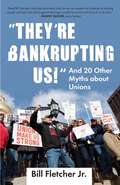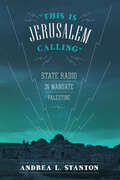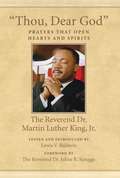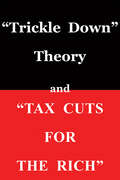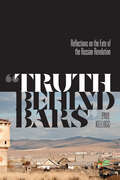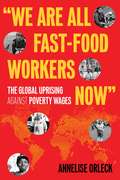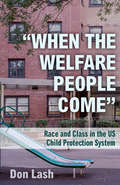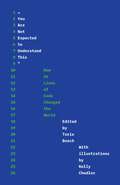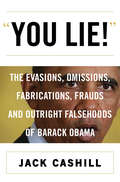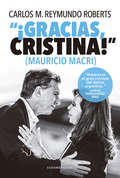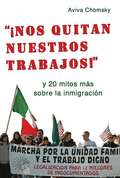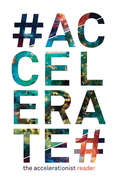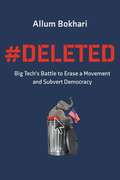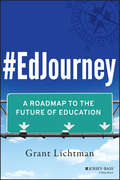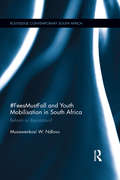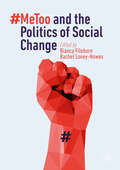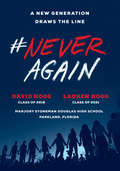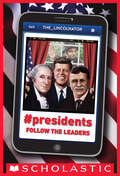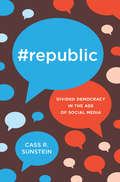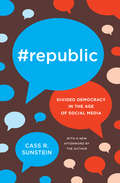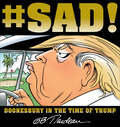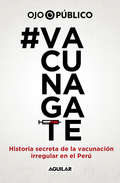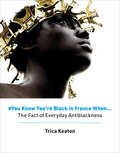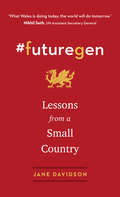- Table View
- List View
"They're Bankrupting Us!"
by Bill Fletcher Jr.From Wisconsin to Washington, DC, the claims are made: unions are responsible for budget deficits, and their members are overpaid and enjoy cushy benefits. The only way to save the American economy, pundits claim, is to weaken the labor movement, strip workers of collective bargaining rights, and champion private industry. In "They're Bankrupting Us!": And 20 Other Myths about Unions, labor leader Bill Fletcher Jr. makes sense of this debate as he unpacks the twenty-one myths most often cited by anti-union propagandists. Drawing on his experiences as a longtime labor activist and organizer, Fletcher traces the historical roots of these myths and provides an honest assessment of the missteps of the labor movement. He reveals many of labor's significant contributions, such as establishing the forty-hour work week and minimum wage, guaranteeing safe workplaces, and fighting for equity within the workforce. This timely, accessible, "warts and all" book argues, ultimately, that unions are necessary for democracy and ensure economic and social justice for all people.
"This Is Jerusalem Calling": State Radio in Mandate Palestine
by Andrea L. StantonModeled after the BBC, the Palestine Broadcasting Service was launched in 1936 to serve as the national radio station of Mandate Palestine, playing a pivotal role in shaping the culture of the emerging middle class in the region. <P><P>Despite its significance, the PBS has become nearly forgotten by scholars of twentieth-century Middle Eastern studies. Drawn extensively from British and Israeli archival sources, “This Is Jerusalem Calling” traces the compelling history of the PBS’s twelve years of operation, illuminating crucial aspects of a period when Jewish and Arab national movements simultaneously took form.
"Thou, Dear God"
by Martin Luther King Jr."Thou, Dear God" is the first and only collection of sixty-eight prayers by Martin Luther King, Jr. Arranged thematically in six parts--with prayers for spiritual guidance, special occasions, times of adversity, times of trial, uncertain times, and social justice--Baptist minister and King scholar Lewis Baldwin introduces the book and each section with short essays. Included are both personal and public prayers King recited as a seminarian, graduate student, preacher, pastor, and, finally, civil rights leader, along with a special section that reveals the biblical sources that most inspired King. Collectively they illustrate how King turned to private prayer for his own spiritual fulfillment and to public prayer as a way to move, inspire, and reaffirm a quest for peace and social justice. With a foreword by Rev. Dr. Julius R. Scruggs, it is the perfect gift for people and leaders of all faiths, and an invaluable resource for spiritual individuals and those who lead worship.
"Trickle Down Theory" and "Tax Cuts for the Rich"
by Thomas SowellThis essay unscrambles gross misconceptions that have made rational debates about tax policies virtually impossible for decades.
"Truth Behind Bars": Reflections on the Fate of the Russian Revolution
by Paul KelloggJust north of the Arctic Circle is the settlement of Vorkuta, a notorious camp in the Gulag internment system that witnessed three pivotal moments in Russian history. In the 1930s, a desperate hunger strike by socialist prisoners, victims of Joseph Stalin’s repressive regime, resulted in mass executions. In 1953, a strike by forced labourers sounded the death knell for the Stalinist forced labour system. And finally, in the late 1980s and early 1990s, a series of strikes by new, independent miners’ unions were central to overturning the Stalinist system. Paul Kellogg uses the story of Vorkuta as a frame with which to re-assess the Russian Revolution. In particular, he turns to the contributions of Iulii Martov, a contemporary of Lenin, and his analysis of the central role played in the revolution by a temporary class of peasants-in-uniform. Kellogg explores the persistence and creativity of workers’ resistance in even the darkest hours of authoritarian repression and offers new perspectives on the failure of democratic governance after the Russian Revolution.
"We Are All Fast-Food Workers Now": The Global Uprising Against Poverty Wages
by Annelise OrleckThe story of low-wage workers rising up around the world to demand respect and a living wage.Tracing a new labor movement sparked and sustained by low-wage workers from across the globe, "We Are All Fast-Food Workers Now" is an urgent, illuminating look at globalization as seen through the eyes of workers-activists: small farmers, fast-food servers, retail workers, hotel housekeepers, home-healthcare aides, airport workers, and adjunct professors who are fighting for respect, safety, and a living wage. With original photographs by Liz Cooke and drawing on interviews with activists in many US cities and countries around the world, including Bangladesh, Cambodia, Mexico, South Africa, and the Philippines, it features stories of resistance and rebellion, as well as reflections on hope and change as it rises from the bottom up.
"When the Welfare People Come": Race and Class in the US Child Protection System
by Don Lash&“[An] excellent overview of the child welfare system . . . Most importantly, [the author] provides a discussion of how to create true change.&” —Tina Lee, author of Catching a Case: Inequality and Fear in New York City's Child Welfare System A groundbreaking look at the history and politics of the American child welfare system, &“When the Welfare People Come&” exposes the system in its totality, from child protective investigation to foster care and mandated services, arguing that it constitutes a mechanism of control exerted over poor and working class parents and children. Applying the Marxist framework of social reproduction theory to the child welfare system, the author, an attorney who has practiced in the area of child welfare for more than twenty years, reveals the system&’s role in the regulation of family life under capitalism. &“This book&’s description and analysis of child welfare is terrific. Though I&’ve worked in the field of child welfare for four decades, I learned not only new information but also found new, resonant analyses.&” —David Tobis, PhD, Author of From Pariahs to Partners: How Parents and Their Allies Changed New York City&’s Child Welfare System
"You Are Not Expected to Understand This": How 26 Lines of Code Changed the World
by Kelly ChudlerLeading technologists, historians, and journalists reveal the stories behind the computer coding that touches all aspects of life—for better or worseFew of us give much thought to computer code or how it comes to be. The very word “code” makes it sound immutable or even inevitable. “You Are Not Expected to Understand This” demonstrates that, far from being preordained, computer code is the result of very human decisions, ones we all live with when we use social media, take photos, drive our cars, and engage in a host of other activities.Everything from law enforcement to space exploration relies on code written by people who, at the time, made choices and assumptions that would have long-lasting, profound implications for society. Torie Bosch brings together many of today’s leading technology experts to provide new perspectives on the code that shapes our lives. Contributors discuss a host of topics, such as how university databases were programmed long ago to accept only two genders, what the person who programmed the very first pop-up ad was thinking at the time, the first computer worm, the Bitcoin white paper, and perhaps the most famous seven words in Unix history: “You are not expected to understand this.”This compelling book tells the human stories behind programming, enabling those of us who don’t think much about code to recognize its importance, and those who work with it every day to better understand the long-term effects of the decisions they make.With an introduction by Ellen Ullman and contributions by Mahsa Alimardani, Elena Botella, Meredith Broussard, David Cassel, Arthur Daemmrich, Charles Duan, Quinn DuPont, Claire L. Evans, Hany Farid, James Grimmelmann, Katie Hafner, Susan C. Herring, Syeda Gulshan Ferdous Jana, Lowen Liu, John MacCormick, Brian McCullough, Charlton McIlwain, Lily Hay Newman, Margaret O’Mara, Will Oremus, Nick Partridge, Benjamin Pope, Joy Lisi Rankin, Afsaneh Rigot, Ellen R. Stofan, Lee Vinsel, Josephine Wolff, and Ethan Zuckerman.
"You Lie!": The Evasions, Omissions, Fabrications, Frauds and Outright Falsehoods of Barack Obama
by Jack CashillA devastating catalog of Barack Obama’s numerous evasions, misleading statements and blatant lies, from statements in his national bestseller Dreams from My Father to “You can keep your health plan,” PolitiFact’s 2013 “Lie of the Year.”During President Obama’s address to Congress in November 2009, Representative Joe Wilson of South Carolina shouted, “You lie!” As Jack Cashill details, the president has been lying about his personal history and his political philosophy from the beginning of his political career. Yet throughout his meteoric rise and the first five years of his presidency, the liberal media turned a blind eye to his numerous evasions, contradictions, misstatements, deceptions, untruths, and outright falsehoods.It wasn’t until the disastrous Obamacare rollout that the president’s lies caught up with him. Finally, it was impossible even for the mainstream media to ignore the president’s repeated assertions that all Americans could keep their health care plans and family doctors if they so chose. In You Lie! conservative journalist and author Jack Cashill provides a devastating compendium of the president’s false and misleading statements on matters great and small, from the deliberate distortions in his celebrated memoir, Dreams from My Father, to his rise to the White House and his years as president.
"¡Gracias, Cristina!" (Mauricio Macri)
by Carlos M. Reymundo RobertsRecopilación de sus columnas publicadas en La Nación durante -y acerca de- los tres últimos años. El último tiempo del Cristinismo, los escándalos de corrupción política, el triunfo de Macri y la crisis económica son algunos de los temas que atraviesan estos microrrelatos llenos de humor, ironía y realidad. Qué horror: Cristina empieza a despedirse; La orden de Olivos: destruir a Macri; Mi carta abierta al papa Francisco; ¿La Argentina, satélite de China? Puede ser; Media training de apuro para Scioli; A solas con el próximo Presidente; El narcotráfico salvó la campaña; ¡A los botes, Daniel, que naufragamos!; La Cristina que baila (y la que llora y patalea); Perdón, señora, pero voy a votar a Scioli; El imperdonable error de confiar en los argentinos; Miami no va a votar a Scioli; Mi última carta a la Presidenta; Macri, casi un debut y despedida; Golpe de los mercados contra la oposición; Macri trajo las diez plagas de Egipto; Carta urgente a Cristina: ¡vuelva ya!; Los Kirchner no se arrepienten de nada; Cuidado, Macri nos va a congelar a todos; Trump, desnudado por políticos argentinos; Bienvenidos al reality llamado la Argentina; El país de los audios es cruel y despiadado; Che, está muy buena la campaña; De Vido, consultor de gobiernos corruptos; Revelo por quién voy a votar; Hay Macri para rato; Cristina, un rato más; Las PASO y después. Y mucho más. Con prólogo de Alfredo Leuco.
"¡Nos Quitan Nuestros Trabajos!"
by Aviva Chomsky"An indispensable guide to the current debate on immigration."-Howard ZinnAviva Chomsky dismantles twenty-one of the most widespread myths and beliefs about immigrants and immigration. "¡Nos Quitan el Trabajo!" challenges the underlying assumptions that fuel these misinformed claims about immigrants, radically altering our notions of citizenship, discrimination, and US history.
#Accelerate: The Accelerationist Reader
by Robin Mackay Armen AvanessianAn apparently contradictory yet radically urgent collection of texts tracing the genealogy of a controversial current in contemporary philosophy.Accelerationism is the name of a contemporary political heresy: the insistence that the only radical political response to capitalism is not to protest, disrupt, critique, or détourne it, but to accelerate and exacerbate its uprooting, alienating, decoding, abstractive tendencies.#Accelerate presents a genealogy of accelerationism, tracking the impulse through 90s UK darkside cyberculture and the theory-fictions of Nick Land, Sadie Plant, Iain Grant, and CCRU, across the cultural underground of the 80s (rave, acid house, SF cinema) and back to its sources in delirious post-68 ferment, in texts whose searing nihilistic jouissance would later be disavowed by their authors and the marxist and academic establishment alike.On either side of this central sequence, the book includes texts by Marx that call attention to his own “Prometheanism,” and key works from recent years document the recent extraordinary emergence of new accelerationisms steeled against the onslaughts of neoliberal capitalist realism, and retooled for the twenty-first century.At the forefront of the energetic contemporary debate around this disputed, problematic term, #Accelerate activates a historical conversation about futurality, technology, politics, enjoyment, and capital. This is a legacy shot through with contradictions, yet urgently galvanized today by the poverty of “reasonable” contemporary political alternatives.
#DELETED: Big Tech's Battle to Erase a Movement and Subvert Democracy
by Allum BokhariThe most powerful tech companies in the world are determined to stop Donald Trump.Journalist Allum Bokhari has spent four years investigating the tech giants that dominate the Internet: Google, Facebook, YouTube, Twitter. He has discovered a dark plot to seize control of the flow of information, and utilize that power to its full extent - to censor, manipulate, and ultimately sway the outcome of democratic elections. His network of whistleblowers inside Google, Facebook and other companies explain how the tech giants now see themselves as "good censors," benevolent commissars controlling the information we receive to "protect" us from "dangerous" speech.They reveal secret methods to covertly manipulate online information without us ever being aware of it, explaining how tech companies can use big data to target undecided voters. They lift the lid on a plot four years in the making - a plot to use the power of technology to stop Donald Trump's re-election.
#DoNotDisturb: How I Ghosted My Cell Phone to Take Back My Life
by Jedediah BilaHave you ever looked at your email, then texts, then Facebook, then Twitter, then email, then Instagram, then Candy Crush, then texts, then Snapchat, then texts again, and now you’ve wasted the time you had set aside for more important things? Jedediah Bila has solved her own Obsessive Compulsive Tech Disorder, and she did it without throwing away her devices.It's time to switch on airplane mode and settle into Jedediah Bila’s #DoNotDisturb: How I Ghosted My Cell Phone to Take Back My Life.In this timely, entertaining and inspiring book, Jedediah Bila chronicles her chaotic, confusing, and all-consuming love-hate relationship with - her cell phone. Stepping back from the whirlwind of texting, social media, and an endless sea of apps, Bila questions how our relationships, character, and sanity have suffered from our deep dive into the digital abyss. Exploring the toll that tech addiction took on her life, Bila reveals her missteps and mistakes, including several upending, life-altering months swirling in an ex-boyfriend’s cell-phone-enabled double life, and how a low-tech millennial later stole her heart.Travel with Jedediah through the embarrassing and catastrophic consequences of Ménage-a-Tech relationships, social media's Perception Deception, and the One-Potato-Chip-Problem of trying to resist Silicon Valley's hypnotic, slot-machine software designed to lure you in. Bila reveals how she navigated away from an unhealthy, oversaturated diet of tech junk food to striking just the right balance with technology to let her unplugged, real-life moments take charge. In #DoNotDisturb, Bila applies her trademark no-nonsense, common-sense, personal responsibility and accountability-centered approach, warning us that if we don’t stop acting like robots, our very humanity is at stake. Through warm anecdotes and cold, hard truths, Bila reveals how she pulled her way out of the tech fog to keep her eyes focused on the life right in front of her. And how you can too.
#EdJourney
by Grant LichtmanYour formula for managing innovation and transforming learning #EdJourney: A Roadmap to the Future of Education is a refreshing change from the negativity so common in the world of education today. Over the course of a 3-month solo road trip across the United States, author Grant Lichtman discovered that there is much to be positive about in today's K-12 schools. Lichtman, one of the country's leading experts in educational innovation, interviewed over 600 teachers, administrators, students, parents, and trustees to find out what kind of innovations they're doing right--and how others can leverage their successes. Innovation in education takes hard work, planning, and cooperation. With examples from around the country and findings from the latest education research, #EdJourney maps out how administrators and teachers can embrace the innovation process that schools and learners need now. Today's 21st century education presents unique challenges and opportunities to students, and this is a trailblazing practical guide to making sure education is ready for the future. #EdJourney focuses on four key questions: What new learning strategies are the top schools implementing to prepare our students for their future rather than for our past? How do teachers and administrators manage transitions to new types of teaching and learning? What are the key obstacles to shifting away from the assembly line model of education? How can we all leverage the lessons of success from the most innovative schools? The concrete examples and advice in this book will help you bring innovation and educational design concepts into your school. #EdJourney goes beyond the theoretical need for change--by now a familiar topic to almost everyone--and takes a real-world approach to achieving transformative education in any school.
#FeesMustFall and Youth Mobilisation in South Africa: Reform or Revolution? (Routledge Contemporary South Africa)
by Musawenkosi W NdlovuThis book examines the historical FeesMustFall (FMF) university student protests that took place in South Africa and shows how the enduring historical construction, representation and conceptualisation of South African youth (as typically radical and political) contributed to the (mis)interpretation of FMF protests, and led to a discourse on an African National Congress-toppling revolution. Arguing that the student protests were not the revolutionary movement they have been represented as, Ndlovu demonstrates that ideological divisions amongst the protestors, the declining economy, and reduced youth participation in the political public sphere cannot lead to a new revolution in South African politics. This book will be of interest to students and scholars interested in South African politics, higher education, democracy and protest movements.
#MeToo and the Politics of Social Change
by Bianca Fileborn Rachel Loney-Howes#MeToo has sparked a global re-emergence of sexual violence activism and politics. This edited collection uses the #MeToo movement as a starting point for interrogating contemporary debates in anti-sexual violence activism and justice-seeking. It draws together 19 accessible chapters from academics, practitioners, and sexual violence activists across the globe to provide diverse, critical, and nuanced perspectives on the broader implications of the movement. It taps into wider conversations about the nature, history, and complexities of anti-rape and anti-sexual harassment politics, including the limitations of the movement including in the global South. It features both internationally recognised and emerging academics from across the fields of criminology, media and communications, film studies, gender and queer studies, and law and will appeal broadly to the academic community, activists, and beyond.
#NeverAgain: A New Generation Draws the Line
by David Hogg Lauren HoggFrom two survivors of the Parkland, Florida, shooting comes a declaration for our times, and an in-depth look at the making of the #NeverAgain movement. <P><P> On February 14, 2018, seventeen-year-old David Hogg and his fourteen-year-old sister, Lauren, went to school at Marjory Stoneman Douglas High School, like any normal Wednesday. That day, of course, the world changed. <P><P>By the next morning, with seventeen classmates and faculty dead, they had joined the leadership of a movement to save their own lives, and the lives of all other young people in America. <P><P>It's a leadership position they did not seek, and did not want--but events gave them no choice. <P><P>The morning after the massacre, David Hogg told CNN: "We're children. You guys are the adults. You need to take some action and play a role. Work together. Get over your politics and get something done." <P><P>This book is a manifesto for the movement begun that day, one that has already changed America--with voices of a new generation that are speaking truth to power, and are determined to succeed where their elders have failed. <P>With moral force and clarity, a new generation has made it clear that problems previously deemed unsolvable due to powerful lobbies and political cowardice will be theirs to solve. <P><P>Born just after Columbine and raised amid seemingly endless war and routine active shooter drills, this generation now says, Enough. This book is their statement of purpose, and the story of their lives. It is the essential guide to the #NeverAgain movement.
#Presidents: Follow the Leaders
by John Bailey OwenWas Teddy Roosevelt a cute kid in his Throwback Thursday photos? Whose no-shave November facial hair is better, Lincoln's or Taft's? And just how many selfies did JFK take in the oval office? From how they grew up to how they led, learn what historians know about these incredible leaders and find out what they're saying to each other! Follow the leaders!
#Republic: Divided Democracy in the Age of Social Media
by Cass R. SunsteinAs the Internet grows more sophisticated, it is creating new threats to democracy. Social media companies such as Facebook can sort us ever more efficiently into groups of the like-minded, creating echo chambers that amplify our views. It's no accident that on some occasions, people of different political views cannot even understand each other. It's also no surprise that terrorist groups have been able to exploit social media to deadly effect.Welcome to the age of #Republic.In this revealing book, Cass Sunstein, the New York Times bestselling author of Nudge and The World According to Star Wars, shows how today's Internet is driving political fragmentation, polarization, and even extremism—and what can be done about it.Thoroughly rethinking the critical relationship between democracy and the Internet, Sunstein describes how the online world creates "cybercascades," exploits "confirmation bias," and assists "polarization entrepreneurs." And he explains why online fragmentation endangers the shared conversations, experiences, and understandings that are the lifeblood of democracy.In response, Sunstein proposes practical and legal changes to make the Internet friendlier to democratic deliberation. These changes would get us out of our information cocoons by increasing the frequency of unchosen, unplanned encounters and exposing us to people, places, things, and ideas that we would never have picked for our Twitter feed.#Republic need not be an ironic term. As Sunstein shows, it can be a rallying cry for the kind of democracy that citizens of diverse societies most need.
#Republic: Divided Democracy in the Age of Social Media
by Cass R. SunsteinFrom the New York Times bestselling author of Nudge and The World According to Star Wars, a revealing account of how today's Internet threatens democracy—and what can be done about itAs the Internet grows more sophisticated, it is creating new threats to democracy. Social media companies such as Facebook can sort us ever more efficiently into groups of the like-minded, creating echo chambers that amplify our views. It's no accident that on some occasions, people of different political views cannot even understand one another. It's also no surprise that terrorist groups have been able to exploit social media to deadly effect. Welcome to the age of #Republic.In this revealing book, New York Times bestselling author Cass Sunstein shows how today’s Internet is driving political fragmentation, polarization, and even extremism--and what can be done about it. He proposes practical and legal changes to make the Internet friendlier to democratic deliberation, showing that #Republic need not be an ironic term. Rather, it can be a rallying cry for the kind of democracy that citizens of diverse societies need most.
#SAD!: Doonesbury in the Time of Trump (Doonesbury Ser.)
by G. B. TrudeauFrom the Pulitzer Prize-winning cartoonist whose acclaimed Yuge!: 30 Years of Doonesbury on Trump blew up the bestseller list, comes the sequel millions prayed would be unnecessary. #SAD!: Doonesbury in the Time of Trump tracks the shocking victory, the inept transition, and the tumultuous eternity of POTUS&’s First 500 Days.Citizens who rise every morning in dread, braced for disruptive, Randomly Capitalized, atrociously grammarized, horrably speld, toxic tweeting from the Oval Office, can curl up at night with this clarifying collection of hot takes on the First Sociopath, his enablers, and their appalling legacy. Whether resisting or just persisting, readers will find G.B. Trudeau&’s cartoons are just the thing to ease the pain of remorse (&“Could I have done more to prevent this?&”) and give them a shot at a few hours of unfitful sleep.There are worse things to spend your tax cut on.
#Vacunagate: Historia secreta de la vacunación irregular en el Perú
by OjoPúblicoEl libro que revela la compleja telaraña de influencias, intereses y privilegios en el proceso de vacunación peruano Pocos escándalos públicos de la historia reciente en el Perú han expuesto los hilos del poder con tanta rapidez e impacto como el caso de las vacunas contra la COVID-19, aplicadas en secreto a medio centenar de privilegiados, entre los que se encuentra el expresidente Martín Vizcarra. El equipo periodístico de OjoPúblico ha realizado un exhaustivo trabajo de investigación sobre estas prácticas irregulares, de donde se desprenden varias interrogantes: ¿Cómo fue que un grupo de médicos pudo aplicar las candidatas a vacunas violando principios bioéticos, con la autorización de las autoridades sanitarias del país y vulnerando protocolos esenciales de lo que debía ser un hito en la historia médica peruana? ¿Por qué una pandemia se convierte en un asunto de geopolítica? ¿Cuántas muertes justifican el oportunismo político? #Vacunagate examina el entramado de ciencia, diplomacia, intereses empresariales, vínculos políticos, componendas entre el sector público y privado, y otros factores que explican lo que podría ser una de las mayores muestras de abuso de poder en medio de la pandemia.
#You Know You're Black in France When: The Fact of Everyday Antiblackness
by Trica KeatonA groundbreaking study about everyday antiblackness and its refusal in an officially raceblind France.What does it mean to be racialized-as-black in France on a daily basis? #You Know You&’re Black in France When… responds to that question. Under the banner of universalism, France messages a powerful and seductive ideology of blindness to race that disappears blackened people and the antiblackness they experience. As Tricia Keaton notes, in everyday life, France is anything but raceblind. In this interdisciplinary study, drawn from a range of critical scholarship including that of Philomena Essed and Frantz Fanon, Keaton illuminates how b/Black (racialized/politicized) French people distinctly expose and refuse what she calls &“raceblind republicanism.&” By officially turning a blind eye to the specificity of antiblackness, the French state in fact perpetuates it, she argues, along with structural racism. Through daily life, public policies, visual culture, the private lives of individuals and families shattered by police violence, the French courts where many are fighting back, and her own experiences, Keaton charts the troubling dynamics and continuities of antiblackness in French society.
#futuregen: Lessons from a Small Country
by Jane Davidson"What Wales is doing today, the world will do tomorrow.”—Nikhil Seth, UN Assistant Secretary General <P><P> The story of how one small nation responded to global climate issues by radically rethinking public policy for future generations <P><P> In #futuregen, Jane Davidson explains how, as Minister for Environment, Sustainability and Housing in Wales, she proposed the Well-being of Future Generations (Wales) Act 2015—the first piece of legislation on Earth to place regenerative and sustainable practice at the heart of government. Unparalleled in its scope and vision, the Act connects environmental and social health and looks to solve complex issues such as poverty, education and unemployment. <P><P> Davidson reveals how and why such groundbreaking legislation was forged in Wales—once reliant on its coal, iron and steel industries—and explores how the shift from economic growth to sustainable growth is creating new opportunities for communities and governments all over the world. <P><P> #futuregen is the inspiring story of a small, pioneering nation discovering prosperity through its vast natural beauty, renewable energy resources and resilient communities. It’s a living, breathing prototype for local and global leaders as proof of what is possible in the fight for a sustainable future.
